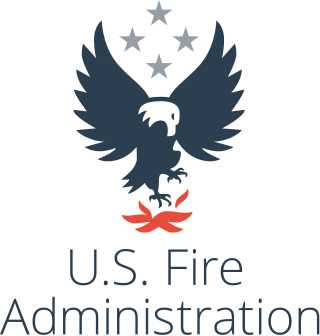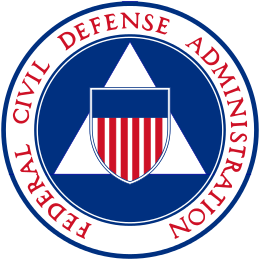
In the United States, community emergency response team (CERT) can refer to

Federal Emergency Management Agency (FEMA) is an agency of the United States Department of Homeland Security (DHS), initially created under President Jimmy Carter by Presidential Reorganization Plan No. 3 of 1978 and implemented by two Executive Orders on April 1, 1979. The agency's primary purpose is to coordinate the response to a disaster that has occurred in the United States and that overwhelms the resources of local and state authorities. The governor of the state in which the disaster occurs must declare a state of emergency and formally request from the President that FEMA and the federal government respond to the disaster. The only exception to the state's gubernatorial declaration requirement occurs when an emergency or disaster takes place on federal property or to a federal asset—for example, the 1995 bombing of the Alfred P. Murrah Federal Building in Oklahoma City, Oklahoma, or the Space Shuttle Columbia in the 2003 return-flight disaster.
Earthquake preparedness is a set of measures taken at the individual, organisational and societal level to minimise the effects of an earthquake. Preparedness measures can range from securing heavy objects, structural modifications and storing supplies, to having insurance, an emergency kit, and evacuation plans.

Emergency management or disaster management is a science and a system charged with creating the framework within which communities reduce vulnerability to hazards and cope with disasters. Emergency management, despite its name, does not actually focus on the management of emergencies, which can be understood as minor events with limited impacts and are managed through the day-to-day functions of a community. Instead, emergency management focuses on the management of disasters, which are events that produce more impacts than a community can handle on its own. The management of disasters tends to require some combination of activity from individuals and households, organizations, local, and/or higher levels of government. Although many different terminologies exist globally, the activities of emergency management can be generally categorized into preparedness, response, mitigation, and recovery, although other terms such as disaster risk reduction and prevention are also common. The outcome of emergency management is to prevent disasters and where this is not possible, to reduce their harmful impacts.

The United States Fire Administration (USFA) is a division of the Federal Emergency Management Agency (FEMA) located in Frederick County, Maryland, near Emmitsburg. Per the official website, "the mission of the U.S. Fire Administration is to support and strengthen fire and emergency medical services (EMS) and stakeholders to prepare for, prevent, mitigate and respond to all hazards".

The Robert T. Stafford Disaster Relief and Emergency Assistance Act is a 1988 United States federal law designed to bring an orderly and systematic means of federal natural disaster assistance for state and local governments in carrying out their responsibilities to aid citizens. Congress's intention was to encourage states and localities to develop comprehensive disaster preparedness plans, prepare for better intergovernmental coordination in the face of a disaster, encourage the use of insurance coverage, and provide federal assistance programs for losses due to a disaster.

Hazus is a geographic information system-based natural hazard analysis tool developed and freely distributed by the Federal Emergency Management Agency (FEMA).
Preparedness is a set of actions that are taken as precautionary measures in the face of potential disasters. Being prepared helps in achieving goals and in avoiding and mitigating negative outcomes.

The Oklahoma Department of Emergency Management (OEM) is a department of the government of Oklahoma responsible for coordinating the response to a natural disaster that has occurred in the State and that has overwhelmed the abilities of local authorities. This is achieved primarily through the development and maintenance of a comprehensive statewide emergency management plan. OEM is responsible for coordinating the efforts of the federal government with other state departments and agencies, county and municipal governments and school boards, and with private agencies that have a role in emergency management.

The Center for Domestic Preparedness (CDP) is the only U.S. federal facility chartered to provide comprehensive preparedness training programs to the nation's emergency response providers. The facility, located in Calhoun County, Alabama, provides all-hazards training to approximately 50,000 emergency responders annually, or a total of 1.1 million responders since its inception in 1998. Trainees hail from state, local, tribal, territorial, and federal governments, as well as private entities. Training for state, local, tribal, and territorial governments are entirely funded by the United States Department of Homeland Security (DHS), whereas responders for foreign federal governments and private entities may be trained on a fee-for-service basis.
The California Governor's Office of Emergency Services is a California cabinet-level office responsible for overseeing and coordinating emergency preparedness, response, recovery and homeland security activities within the state. The agency was created by AB 38 (2008), superseding both the Office of Emergency Services (OES) and Office of Homeland Security (OHS).
Emergency management software is the software used by local, state and federal emergency management personnel to deal with a wide range of disasters and can take many forms. For example, training software such as simulators are often used to help prepare first responders, word processors can keep form templates handy for printing and analytical software can be used to perform post-hoc examinations of the data captured during an incident. All of these systems are interrelated, as the results of an after-incident analysis can then be used to program training software to better prepare for a similar situation in the future. Crisis Information Management Software (CIMS) is the software found in emergency management operation centers (EOC) that supports the management of crisis information and the corresponding response by public safety agencies.
The National Fire Academy (NFA) is one of two schools in the United States operated by the Federal Emergency Management Agency (FEMA) at the National Emergency Training Center (NETC) in Emmitsburg, Maryland. Operated and governed by the United States Fire Administration (USFA) as part of the U.S. Department of Homeland Security (DHS), the NFA is the country’s preeminent federal fire training and education institution. The original purpose of the NFA as detailed in a 1973 report to Congress was to "function as the core of the Nation's efforts in fire service education—feeding out model programs, curricula, and information..."

The State Guard Association of the United States (SGAUS) is a non-profit organization advocating for the advancement and support of regulated state military forces, as established by state governments under the authority of federal law. The SGAUS encourages the establishment and advancement of regulated state forces through lobbying and affiliation with independent state associations.
The Stephenson Disaster Management Institute at Louisiana State University is located in the Stephenson National Center for Security Research and Training at LSU.

The Emergency Management (EM) career field is the United States Air Force's (USAF) primary organization responsible for implementing an installation-level EM program. Emergency Managers, also known by the Air Force Specialty Code (AFSC) 3E9X1, are the Air Force's subject matter experts for all non-medical Chemical, Biological, Radiological and Nuclear (CBRN) passive defense and consequence management matters.
During wartime operations, 3E9X1s are assigned to CBRN reconnaissance teams responsible for detecting, identifying, quantifying, and collecting CBRN material ensuring mission continuation and force survivability.
The National Domestic Preparedness Consortium (NDPC) is a training partner and established training arm of the U.S. Department of Homeland Security DHS/FEMA. It is a professional alliance of seven national institutions and organizations that work to develop and deliver training, technical assistance, plan assessments, and exercises to emergency responders and first receivers at the territories, state, local and tribal levels. The members were chosen for their unique knowledge bases in the areas of chemical, biological, radiological, nuclear, explosive, medical, critical infrastructure, and incident management, and have enhanced their core competencies at the request of DHS and FEMA to include other areas as well. The following is a list of the NDPC members and their core competencies:

The National Emergency Training Center (NETC) serves as an interagency emergency management training body for the United States government. The college campus was purchased by the U.S. Government in 1979 for use as the National Emergency Training Center. NETC is home to the National Fire Academy, United States Fire Administration, Emergency Management Institute (EMI), which is operated by the Directorate of Preparedness branch of the Federal Emergency Management Agency (FEMA). The campus also includes the learning resource center (LRC) library, the National Fire Data Center, and the National Fallen Firefighters Memorial.

Robert J. Fenton Jr is an American governmental official who worked for the Federal Emergency Management Agency (FEMA) in 1996 and was appointed Regional Administrator for FEMA Region IX: Arizona, California, Hawaii, Nevada, and the Pacific Islands in July 2015. He had a leadership role in the development of the National Incident Management System and the National Response Framework.
The National Earthquake Hazards Reduction Program (NEHRP) was established in 1977 by the United States Congress as part of the Earthquake Hazards Reduction Act of 1977. The original stated purpose for NEHRP was "to reduce the risks of life and property from future Earthquakes in the United States through the establishment and maintenance of an effective earthquake hazards reduction program." Congress periodically reviews and reauthorizes NEHRP, with the most recent review happening in 2018.





























